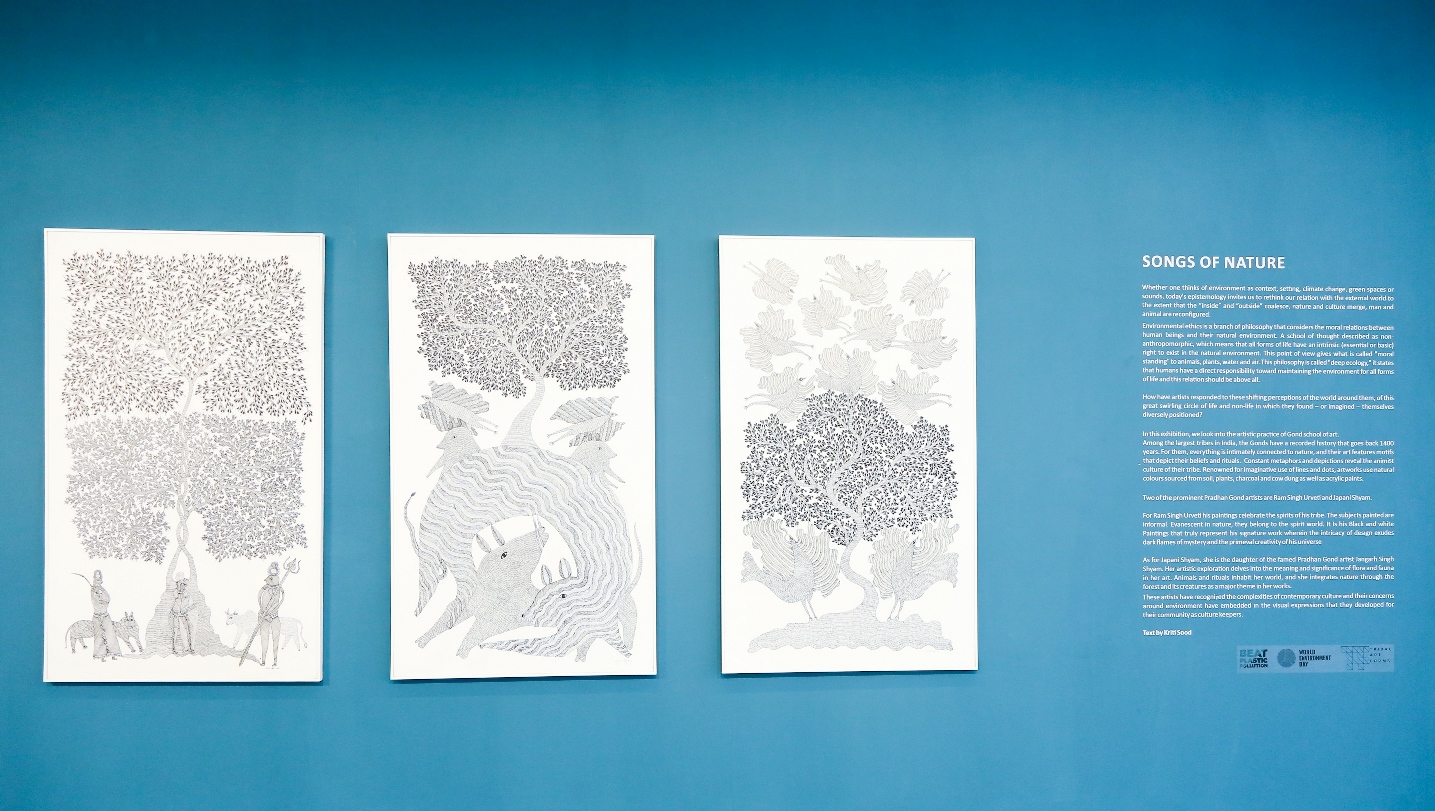
SONGS OF NATURE
SONGS OF NATURE
Whether one thinks of environment as context, setting, climate change, green spaces or sounds, today’s epistemology invites us to rethink our relation with the external world to the extent that the “inside” and “outside” coalesce, nature and culture merge, man and animal are reconfigured.
Environmental ethics is a branch of philosophy that considers the moral relations between human beings and their natural environment. A school of thought described as non-anthropomorphic, which means that all forms of life have an intrinsic (essential or basic) right to exist in the natural environment. This point of view gives what is called "moral standing" to animals, plants, water and air. This philosophy is called "deep ecology," it states that humans have a direct responsibility toward maintaining the environment for all forms of life and this relation should be above all. How have artists responded to these shifting perceptions of the world around them, of this great swirling circle of life and non-life in which they found – or imagined – themselves diversely positioned?
In this exhibition, we look into the artistic practice of Gond school of art. Among the largest tribes in India, the Gonds have a recorded history that goes back 1400 years. For them, everything is intimately connected to nature, and their art features motifs that depict their beliefs and rituals. Constant metaphors and depictions reveal the animist culture of their tribe. Renowned for imaginative use of lines and dots, artworks use natural colours sourced from soil, plants, charcoal and cow dung as well as acrylic paints.
Two of the prominent Pradhan Gond artists are Ram Singh Urveti and Japani Shyam.
For Ram Singh Urveti his paintings celebrate the spirits of his tribe. The subjects painted are informal. Evanescent in nature, they belong to the spirit world. It Is his Black and white Paintings that truly represent his signature work wherein the intricacy of design exudes dark flames of mystery and the primeval creativity of his universe.
As for Japani Shyam, she is the daughter of the famed Pradhan Gond artist Jangarh Singh Shyam. Her artistic exploration delves into the meaning and significance of flora and fauna in her art. Animals and rituals inhabit her world, and she integrates nature through the forest and its creatures as a major theme in her works.
These artists have recognized the complexities of contemporary culture and their concerns around environment have embedded in the visual expressions that they developed for their community as culture keepers.
Display View

SONGS OF NATURE
SONGS OF NATURE
Whether one thinks of environment as context, setting, climate change, green spaces or sounds, today’s epistemology invites us to rethink our relation with the external world to the extent that the “inside” and “outside” coalesce, nature and culture merge, man and animal are reconfigured.
Environmental ethics is a branch of philosophy that considers the moral relations between human beings and their natural environment. A school of thought described as non-anthropomorphic, which means that all forms of life have an intrinsic (essential or basic) right to exist in the natural environment. This point of view gives what is called "moral standing" to animals, plants, water and air. This philosophy is called "deep ecology," it states that humans have a direct responsibility toward maintaining the environment for all forms of life and this relation should be above all. How have artists responded to these shifting perceptions of the world around them, of this great swirling circle of life and non-life in which they found – or imagined – themselves diversely positioned?
In this exhibition, we look into the artistic practice of Gond school of art. Among the largest tribes in India, the Gonds have a recorded history that goes back 1400 years. For them, everything is intimately connected to nature, and their art features motifs that depict their beliefs and rituals. Constant metaphors and depictions reveal the animist culture of their tribe. Renowned for imaginative use of lines and dots, artworks use natural colours sourced from soil, plants, charcoal and cow dung as well as acrylic paints.
Two of the prominent Pradhan Gond artists are Ram Singh Urveti and Japani Shyam.
For Ram Singh Urveti his paintings celebrate the spirits of his tribe. The subjects painted are informal. Evanescent in nature, they belong to the spirit world. It Is his Black and white Paintings that truly represent his signature work wherein the intricacy of design exudes dark flames of mystery and the primeval creativity of his universe.
As for Japani Shyam, she is the daughter of the famed Pradhan Gond artist Jangarh Singh Shyam. Her artistic exploration delves into the meaning and significance of flora and fauna in her art. Animals and rituals inhabit her world, and she integrates nature through the forest and its creatures as a major theme in her works.
These artists have recognized the complexities of contemporary culture and their concerns around environment have embedded in the visual expressions that they developed for their community as culture keepers.
Display View
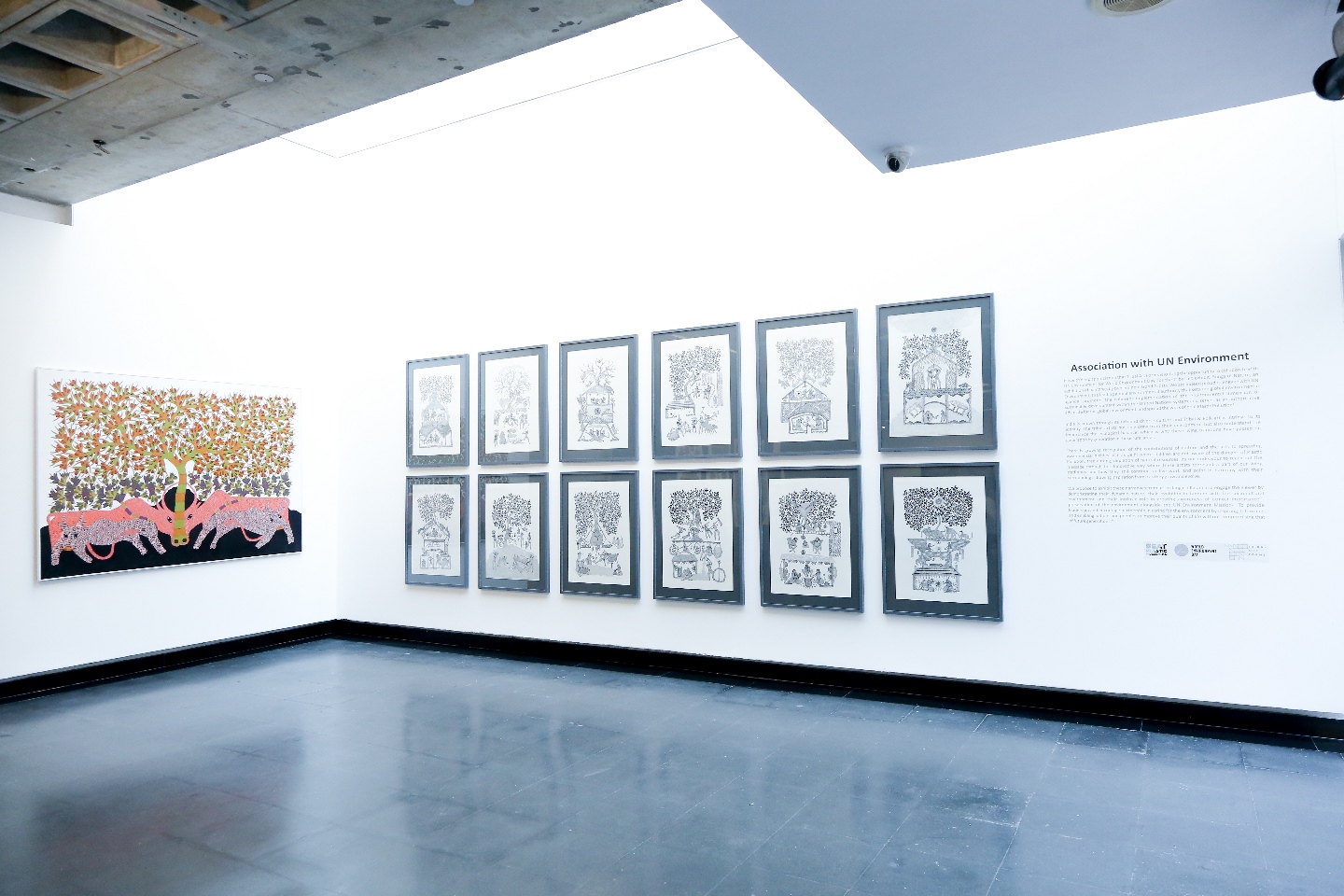
SONGS OF NATURE
SONGS OF NATURE
Whether one thinks of environment as context, setting, climate change, green spaces or sounds, today’s epistemology invites us to rethink our relation with the external world to the extent that the “inside” and “outside” coalesce, nature and culture merge, man and animal are reconfigured.
Environmental ethics is a branch of philosophy that considers the moral relations between human beings and their natural environment. A school of thought described as non-anthropomorphic, which means that all forms of life have an intrinsic (essential or basic) right to exist in the natural environment. This point of view gives what is called "moral standing" to animals, plants, water and air. This philosophy is called "deep ecology," it states that humans have a direct responsibility toward maintaining the environment for all forms of life and this relation should be above all. How have artists responded to these shifting perceptions of the world around them, of this great swirling circle of life and non-life in which they found – or imagined – themselves diversely positioned?
In this exhibition, we look into the artistic practice of Gond school of art. Among the largest tribes in India, the Gonds have a recorded history that goes back 1400 years. For them, everything is intimately connected to nature, and their art features motifs that depict their beliefs and rituals. Constant metaphors and depictions reveal the animist culture of their tribe. Renowned for imaginative use of lines and dots, artworks use natural colours sourced from soil, plants, charcoal and cow dung as well as acrylic paints.
Two of the prominent Pradhan Gond artists are Ram Singh Urveti and Japani Shyam.
For Ram Singh Urveti his paintings celebrate the spirits of his tribe. The subjects painted are informal. Evanescent in nature, they belong to the spirit world. It Is his Black and white Paintings that truly represent his signature work wherein the intricacy of design exudes dark flames of mystery and the primeval creativity of his universe.
As for Japani Shyam, she is the daughter of the famed Pradhan Gond artist Jangarh Singh Shyam. Her artistic exploration delves into the meaning and significance of flora and fauna in her art. Animals and rituals inhabit her world, and she integrates nature through the forest and its creatures as a major theme in her works.
These artists have recognized the complexities of contemporary culture and their concerns around environment have embedded in the visual expressions that they developed for their community as culture keepers.
Display View
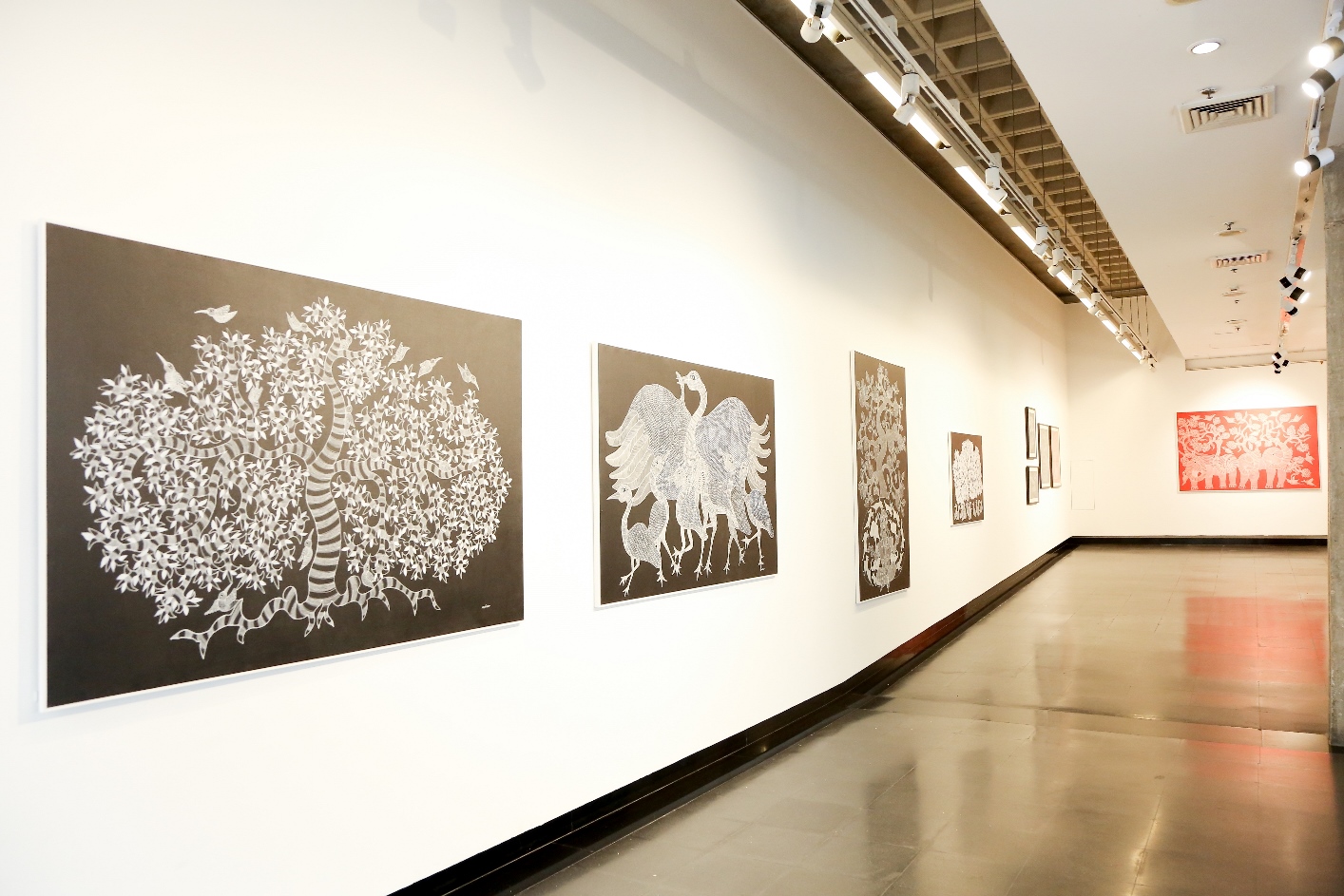
SONGS OF NATURE
SONGS OF NATURE
Whether one thinks of environment as context, setting, climate change, green spaces or sounds, today’s epistemology invites us to rethink our relation with the external world to the extent that the “inside” and “outside” coalesce, nature and culture merge, man and animal are reconfigured.
Environmental ethics is a branch of philosophy that considers the moral relations between human beings and their natural environment. A school of thought described as non-anthropomorphic, which means that all forms of life have an intrinsic (essential or basic) right to exist in the natural environment. This point of view gives what is called "moral standing" to animals, plants, water and air. This philosophy is called "deep ecology," it states that humans have a direct responsibility toward maintaining the environment for all forms of life and this relation should be above all. How have artists responded to these shifting perceptions of the world around them, of this great swirling circle of life and non-life in which they found – or imagined – themselves diversely positioned?
In this exhibition, we look into the artistic practice of Gond school of art. Among the largest tribes in India, the Gonds have a recorded history that goes back 1400 years. For them, everything is intimately connected to nature, and their art features motifs that depict their beliefs and rituals. Constant metaphors and depictions reveal the animist culture of their tribe. Renowned for imaginative use of lines and dots, artworks use natural colours sourced from soil, plants, charcoal and cow dung as well as acrylic paints.
Two of the prominent Pradhan Gond artists are Ram Singh Urveti and Japani Shyam.
For Ram Singh Urveti his paintings celebrate the spirits of his tribe. The subjects painted are informal. Evanescent in nature, they belong to the spirit world. It Is his Black and white Paintings that truly represent his signature work wherein the intricacy of design exudes dark flames of mystery and the primeval creativity of his universe.
As for Japani Shyam, she is the daughter of the famed Pradhan Gond artist Jangarh Singh Shyam. Her artistic exploration delves into the meaning and significance of flora and fauna in her art. Animals and rituals inhabit her world, and she integrates nature through the forest and its creatures as a major theme in her works.
These artists have recognized the complexities of contemporary culture and their concerns around environment have embedded in the visual expressions that they developed for their community as culture keepers.
Display View
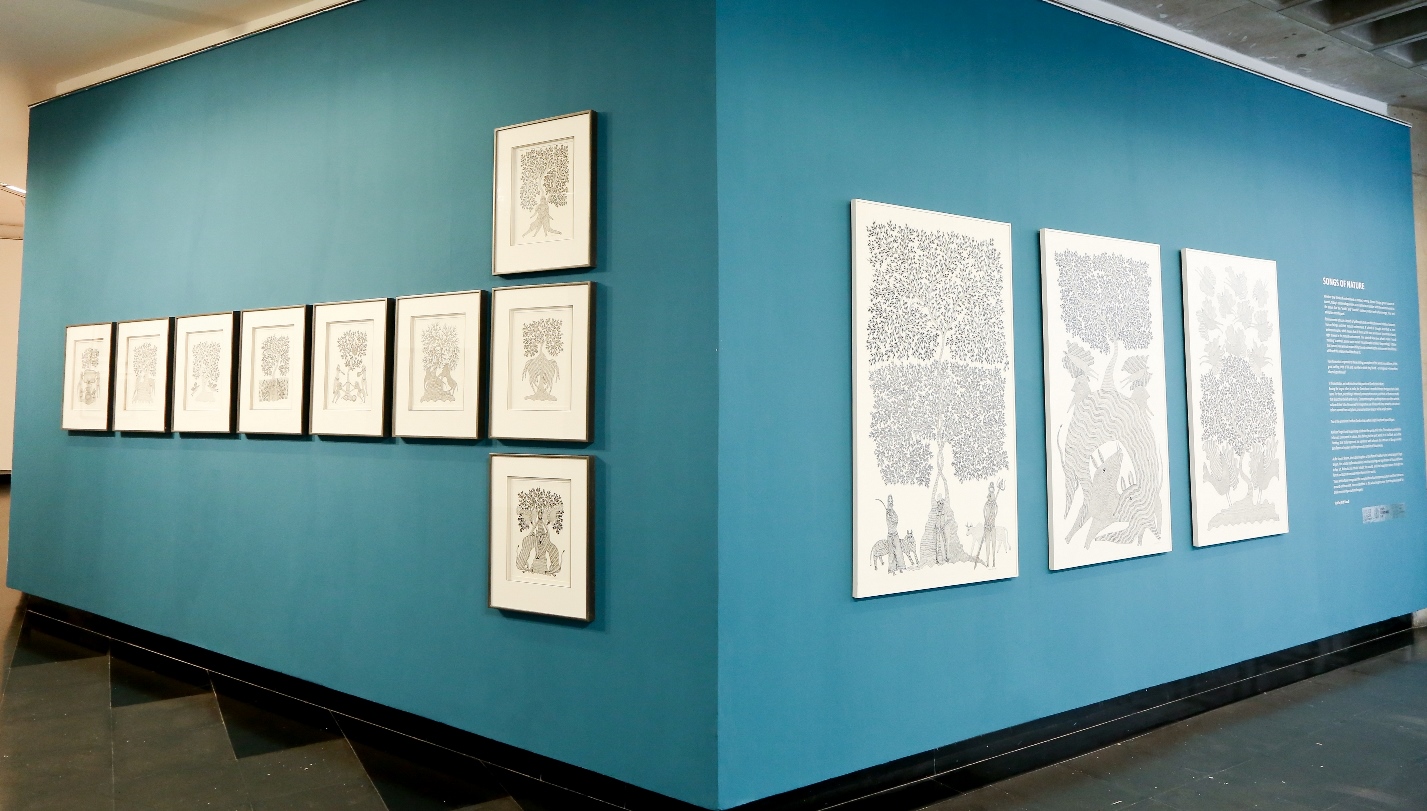
SONGS OF NATURE
SONGS OF NATURE
Whether one thinks of environment as context, setting, climate change, green spaces or sounds, today’s epistemology invites us to rethink our relation with the external world to the extent that the “inside” and “outside” coalesce, nature and culture merge, man and animal are reconfigured.
Environmental ethics is a branch of philosophy that considers the moral relations between human beings and their natural environment. A school of thought described as non-anthropomorphic, which means that all forms of life have an intrinsic (essential or basic) right to exist in the natural environment. This point of view gives what is called "moral standing" to animals, plants, water and air. This philosophy is called "deep ecology," it states that humans have a direct responsibility toward maintaining the environment for all forms of life and this relation should be above all. How have artists responded to these shifting perceptions of the world around them, of this great swirling circle of life and non-life in which they found – or imagined – themselves diversely positioned?
In this exhibition, we look into the artistic practice of Gond school of art. Among the largest tribes in India, the Gonds have a recorded history that goes back 1400 years. For them, everything is intimately connected to nature, and their art features motifs that depict their beliefs and rituals. Constant metaphors and depictions reveal the animist culture of their tribe. Renowned for imaginative use of lines and dots, artworks use natural colours sourced from soil, plants, charcoal and cow dung as well as acrylic paints.
Two of the prominent Pradhan Gond artists are Ram Singh Urveti and Japani Shyam.
For Ram Singh Urveti his paintings celebrate the spirits of his tribe. The subjects painted are informal. Evanescent in nature, they belong to the spirit world. It Is his Black and white Paintings that truly represent his signature work wherein the intricacy of design exudes dark flames of mystery and the primeval creativity of his universe.
As for Japani Shyam, she is the daughter of the famed Pradhan Gond artist Jangarh Singh Shyam. Her artistic exploration delves into the meaning and significance of flora and fauna in her art. Animals and rituals inhabit her world, and she integrates nature through the forest and its creatures as a major theme in her works.
These artists have recognized the complexities of contemporary culture and their concerns around environment have embedded in the visual expressions that they developed for their community as culture keepers.
Display View
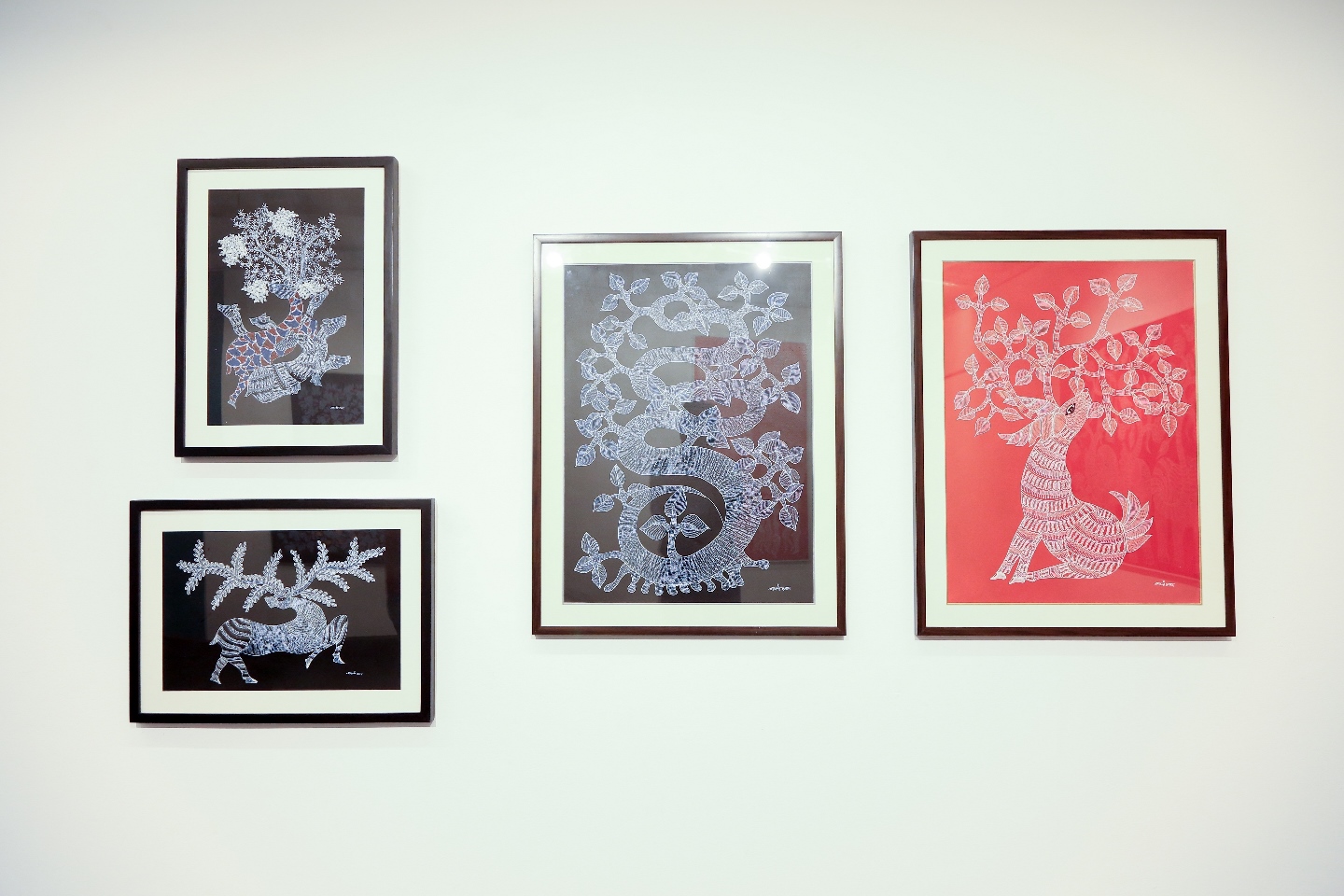
SONGS OF NATURE
SONGS OF NATURE
Whether one thinks of environment as context, setting, climate change, green spaces or sounds, today’s epistemology invites us to rethink our relation with the external world to the extent that the “inside” and “outside” coalesce, nature and culture merge, man and animal are reconfigured.
Environmental ethics is a branch of philosophy that considers the moral relations between human beings and their natural environment. A school of thought described as non-anthropomorphic, which means that all forms of life have an intrinsic (essential or basic) right to exist in the natural environment. This point of view gives what is called "moral standing" to animals, plants, water and air. This philosophy is called "deep ecology," it states that humans have a direct responsibility toward maintaining the environment for all forms of life and this relation should be above all. How have artists responded to these shifting perceptions of the world around them, of this great swirling circle of life and non-life in which they found – or imagined – themselves diversely positioned?
In this exhibition, we look into the artistic practice of Gond school of art. Among the largest tribes in India, the Gonds have a recorded history that goes back 1400 years. For them, everything is intimately connected to nature, and their art features motifs that depict their beliefs and rituals. Constant metaphors and depictions reveal the animist culture of their tribe. Renowned for imaginative use of lines and dots, artworks use natural colours sourced from soil, plants, charcoal and cow dung as well as acrylic paints.
Two of the prominent Pradhan Gond artists are Ram Singh Urveti and Japani Shyam.
For Ram Singh Urveti his paintings celebrate the spirits of his tribe. The subjects painted are informal. Evanescent in nature, they belong to the spirit world. It Is his Black and white Paintings that truly represent his signature work wherein the intricacy of design exudes dark flames of mystery and the primeval creativity of his universe.
As for Japani Shyam, she is the daughter of the famed Pradhan Gond artist Jangarh Singh Shyam. Her artistic exploration delves into the meaning and significance of flora and fauna in her art. Animals and rituals inhabit her world, and she integrates nature through the forest and its creatures as a major theme in her works.
These artists have recognized the complexities of contemporary culture and their concerns around environment have embedded in the visual expressions that they developed for their community as culture keepers.
Display View
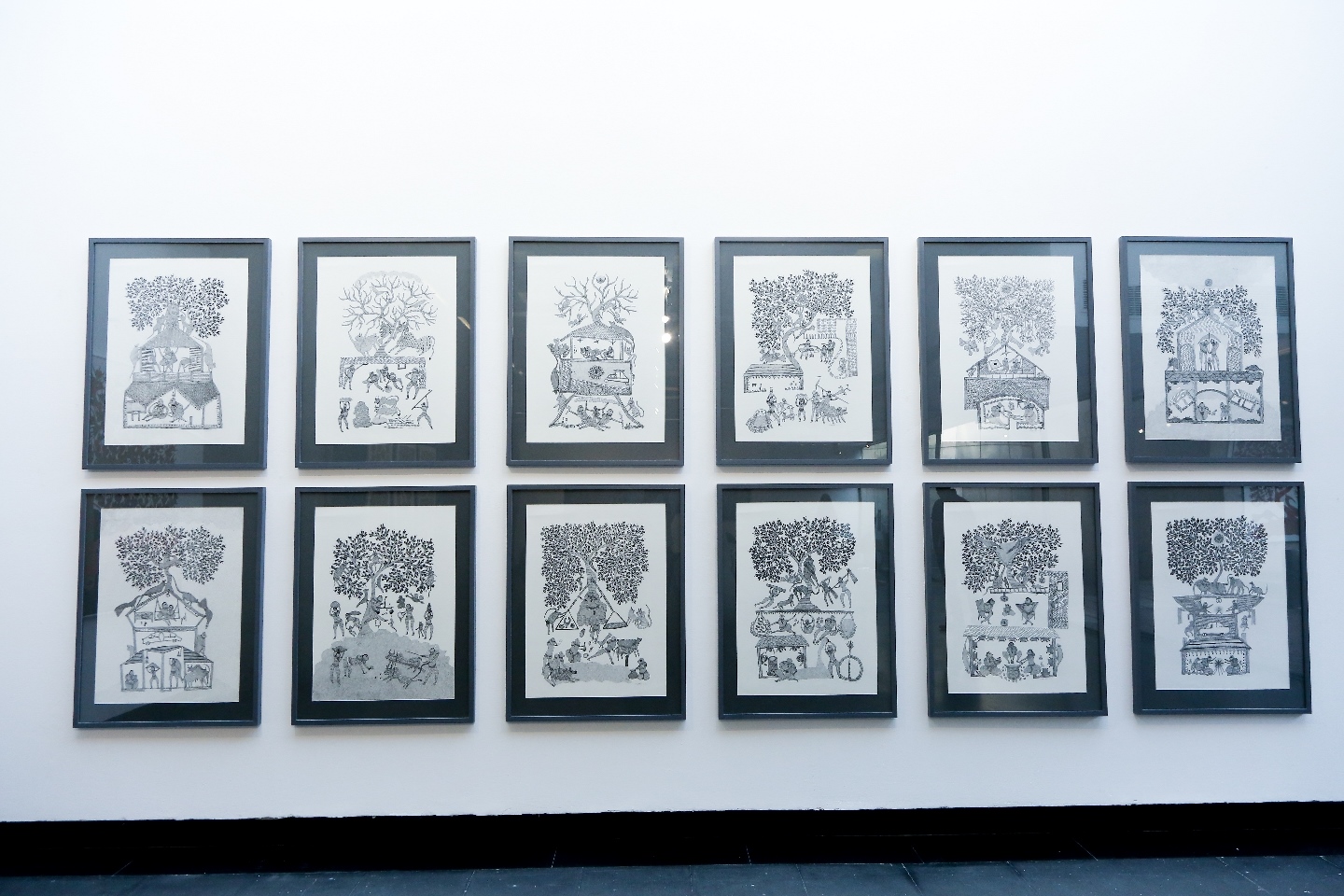
SONGS OF NATURE
SONGS OF NATURE
Whether one thinks of environment as context, setting, climate change, green spaces or sounds, today’s epistemology invites us to rethink our relation with the external world to the extent that the “inside” and “outside” coalesce, nature and culture merge, man and animal are reconfigured.
Environmental ethics is a branch of philosophy that considers the moral relations between human beings and their natural environment. A school of thought described as non-anthropomorphic, which means that all forms of life have an intrinsic (essential or basic) right to exist in the natural environment. This point of view gives what is called "moral standing" to animals, plants, water and air. This philosophy is called "deep ecology," it states that humans have a direct responsibility toward maintaining the environment for all forms of life and this relation should be above all. How have artists responded to these shifting perceptions of the world around them, of this great swirling circle of life and non-life in which they found – or imagined – themselves diversely positioned?
In this exhibition, we look into the artistic practice of Gond school of art. Among the largest tribes in India, the Gonds have a recorded history that goes back 1400 years. For them, everything is intimately connected to nature, and their art features motifs that depict their beliefs and rituals. Constant metaphors and depictions reveal the animist culture of their tribe. Renowned for imaginative use of lines and dots, artworks use natural colours sourced from soil, plants, charcoal and cow dung as well as acrylic paints.
Two of the prominent Pradhan Gond artists are Ram Singh Urveti and Japani Shyam.
For Ram Singh Urveti his paintings celebrate the spirits of his tribe. The subjects painted are informal. Evanescent in nature, they belong to the spirit world. It Is his Black and white Paintings that truly represent his signature work wherein the intricacy of design exudes dark flames of mystery and the primeval creativity of his universe.
As for Japani Shyam, she is the daughter of the famed Pradhan Gond artist Jangarh Singh Shyam. Her artistic exploration delves into the meaning and significance of flora and fauna in her art. Animals and rituals inhabit her world, and she integrates nature through the forest and its creatures as a major theme in her works.
These artists have recognized the complexities of contemporary culture and their concerns around environment have embedded in the visual expressions that they developed for their community as culture keepers.
Display View

